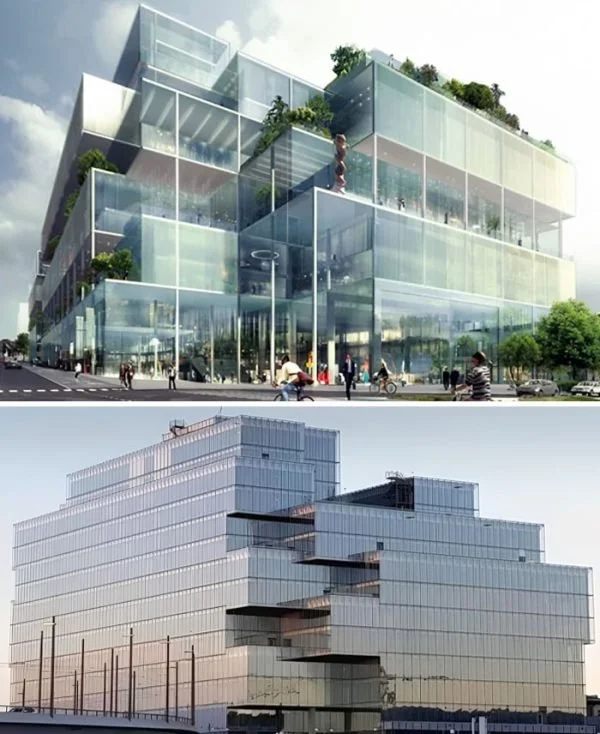The Danger of Early Visuals: Clients Fall in Love Too Fast
Here’s the hard truth nobody wants to admit:
When you show a client a visualization too early, it doesn’t matter how many disclaimers you give — that becomes the project in their mind.
Even if:
the massing hasn’t been tested,
the finishes are placeholders,
the budget isn’t aligned,
the layout will almost certainly evolve,
and the render is basically architectural fanfiction.
Humans attach to what they can see. It’s not their fault — it’s biology.
A rendered image feels real long before reality exists. And once that visual lodges into a client’s imagination, every future design move gets judged against it.
If you’ve worked in architecture, interiors, or development in the past five years, you’ve felt the shift.
Clients used to say, “Let’s review the concept first.” Now they say, “Can you send a render?” Visualization has moved from being the final flourish to being the very first deliverable — before massing is resolved, before constraints are known, before the real work has even begun.
This isn’t just a trend. It’s a fundamental change in how projects begin, how expectations are set, and how design teams must communicate.
And while early visualization opens all kinds of doors — for fundraising, community engagement, marketing, investor pitching — it also introduces a complicated new challenge:
Clients fall in love too early.
Let’s talk about that.
The Risks of Early Visualization (Let’s Tell the Truth)
Early renders can accidentally undermine the process if we’re not careful.
Some key risks include:
1. Design Freeze Too Soon
Clients get attached emotionally, not logically.
Suddenly changing the massing feels like “losing” something.
2. Misalignment With Reality
That dreamy sunlight coming through the window?
Yeah, turns out the site is north-facing.
3. Budget Shock
High-end visualization can imply high-end finishes.
Clients assume the render = the cost.
4. Community or Stakeholder Confusion
Once an image hits a public meeting or fundraiser, it spreads faster than design teams can update it.
Suddenly everyone thinks the project is further along than it is.
So Why Do We Still Do It? Because It Works.
Visualization is persuasive.
It builds momentum.
It secures funding.
It excites donors.
It rallies communities.
It makes abstract ideas tangible.
In many cases:
A strong early visualization is what gets the project off the ground at all.
We’re not fighting the trend — we’re harnessing it.
The Designer’s New Role: Guide the Expectation, Not the Image
Instead of resisting early visualization, we refine the workflow around it.
Here’s how forward-looking design teams are adapting:
1. Make the “Phase Zero Disclaimer” Explicit
Clients aren’t insulting you when they misunderstand a concept image — they’re just reacting like humans.
So we explain the rules upfront:
“This rendering explores direction, not final detail.”
“Design decisions are downstream from budget, zoning, engineering, and codes.”
“Think of this as Act I, not the whole movie.”
2. Use Scaffolding Visuals — Not Fully Styled Ones
Clay renders
Light massing
Material-agnostic studies
Diagrammatic interiors
Muted palettes
These let clients engage without attaching too hard.
3. Create a Before/After Track
To avoid “what happened to the pretty picture?” moments, show:
The early concept
The design evolution
The final resolution
Clients love seeing the transformation — and it proves the process matters.
4. Build in Visual Checkpoints
Structured reviews:
Clay → Preview → Pre-Final → Final
with notes attached to each stage.
This keeps everyone aligned and prevents emotional whiplash.
What Early Visualization Actually Means for the Industry
We’re entering a new era where the first question is always:
“Can you show me what it’ll look like?”
And honestly?
That’s okay — as long as we acknowledge what that does to the process.
Early visualization doesn’t replace design.
It just moves the storytelling earlier in the timeline.
Designers aren’t losing control —
we’re gaining a new responsibility:
setting the emotional tone of the project before the design itself exists.
It’s an art.
It’s a negotiation.
And it’s powerful when done with intention.


